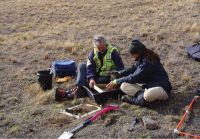A High Country C monitoring project

Soil C monitoring in the South Island High Country.
A MAF Sustainable Farming Fund (SFF) grant and other organisations have supported us to investigate the effects of grazing on ecosystem C stocks in South Island High Country grasslands.
The project is exploratory and any changes are expected to be small, although due to the extent of land involved the potential to affect New Zealand and High Country C accounting is large.
The team set up a trial to test for the effects of land-use change on the ecosystem, selecting three locations with a known history of altered grazing management. in the headwaters of the Rakaia, Waitaki and Clutha (Table 1).
Table 1. Key characteristics of locations selected for field sampling in April/May 2010.
| Location | Elevation(m) | Rainfall (mm) | Topography | Predominant vegetation | Years since grazing change |
|---|---|---|---|---|---|
| Rakaia | 1100–1400 | 1200–1400 | Mountain slopes | Short tussock, Hieracium, Celmisia Spp. | 42 |
| Waitaki | 800–1200 | 900–1000 | Lateral moraine and mountain slopes | Snow tussock, short tussock, matagouri | 28 |
| Clutha | 300–400 | 3000–4000 | River terraces and fans | Exotic pasture grasses,lotus | 12 |
At each location comparable blocks of land were chosen: one block had been retired from sheep grazing and its paired block had continued with grazing as normal.
To ensure pairs of blocks were as similar as possible they were constrained within prescribed limits of elevation, slope, aspect and substrate. C stocks, elevation, aspect, slope, exposure, plant species, size and cover, sign of grazing and relative abundance were measured at about 20 random sample plots within each block. Quantitative samples from one square metre of above-ground vegetation biomass, litter, below-ground vegetation, and soil bulk density at 3 depths to 30 cm were collected. Samples are currently being processed in the laboratory to quantify component C stocks and to determine if there is a difference in ecosystem C between land-use blocks.
The team anticipates the results will be influenced by:
- highly spatial variability of soil C even within the same soil type
- the presence of other grazing animals although sheep have been removed
- colder and drier sites where any observed C change may be occurring more slowly
- invasive weeds such as Hieracium which alter vegetation ground cover
- fertiliser application, stocking rates, the time period since retirement, and the size of the labile soil C component.
It is uncertain if and how ecosystem C has changed as a result of any modifi cation by Maori and early European pastoral practices. Our results will contribute valuable data to work on tussock grasslands. In addition, our findings will be presented via the MAF (SFF) website during the coming year.
Larry Burrows, Richard Clayton & Ian Lynn
